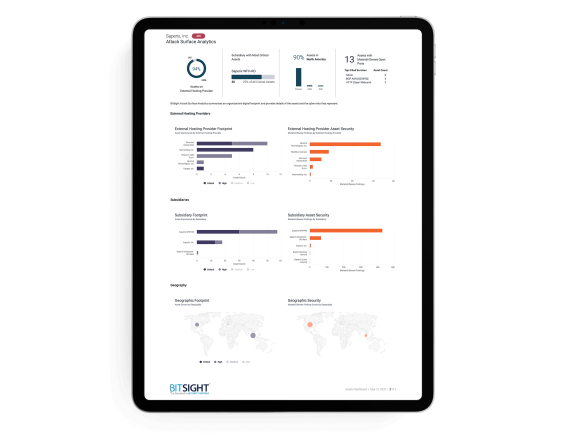Request your free custom report and see how you can start reducing your cyber risk exposure across your digital ecosystem: cloud assets across all geos & subsidiaries; discover shadow IT; security risk findings; and more!
Reduce the Threat of Cyber Intrusion: See Your Network the Way a Hacker Does

Threat actors are constantly looking to execute cyber intrusions. Far from random, these attacks are focused, methodical, and well-planned. But by understanding how hackers work and the vulnerabilities they exploit, you can be better prepared to protect and defend against these intrusions.
What is Cyber Intrusion?
A cyber intrusion occurs when a malicious actor gains access to applications or systems with the intent of causing harm or stealing sensitive data. A cyber intrusion can take many forms, including phishing, SQL injection, and infecting emails. But before these attacks are executed, hackers spend time probing an organization’s network looking for vulnerabilities, gathering information on employees (such as credentials found on the dark web), and forming a plan to exploit their understanding of the company’s digital footprint to commence their attack.
How to Detect and Prevent Cyber Intrusion
To reduce the risk of cyber intrusion, it’s important to develop an intrusion detection and prevention policy and process. Consider the following strategies:
In third party risk management, continuous monitoring involves constantly evaluating vendors' security posture and the risk that each vendor poses to the organization. Rather than assessments that only evaluate vendor risk annually, continuous monitoring provides organizations and CIOs with immediate warnings of changes in vendors' security status.
Third party risk management is the task of understanding and mitigating the risk associated with outsourcing work and services to third-party vendors. A breach in a vendor's network can potentially impact all connected organizations. Third party risk management solutions help to identify the risk and security posture of vendors, allowing security teams to manage vendor relationships in ways that protect the organization more effectively.
1. Create a Continuous Monitoring and Improvement Plan
Digital transformation, cloud technology, and remote work have increased almost every organization's attack surface, creating more opportunities for system and application vulnerabilities to creep in. These weaknesses can seem innocuous, such as an unpatched system or misconfigured application, but these small cracks in your network are easily detected and exploited by hackers.
For example, Bitsight research suggests that organizations that delay applying patches are at increased ransomware risk. In fact, organizations with a patching cadence grade of D or F were more than seven times more likely to experience a ransomware event compared to those with an A grade. Moreover, Bitsight also found that organizations with a C grade or lower for their TLS/SSL certificate and configuration management (a frequent target of hackers) are nearly four times more likely to be ransomware victims.
Identifying these weaknesses across an expanding attack surface requires a coordinated strategy that encompasses regular cyber security vulnerability assessments, scans, and penetration testing exercises.
But as your digital ecosystem continues to expand, new vulnerabilities emerge and cyber intrusion can happen anytime. To combat this risk, consider implementing a continuous monitoring strategy so that you can quickly identify every digital asset on your network, its security posture, areas of concentrated risk, and receive cyber health alerts when new and pressing risks emerge.
With this visibility, you can learn where your cybersecurity falls short, target remediation efforts where they’re needed most, and drive continuous improvement in your security program.
2. Monitor Third-Party and Vendor Applications
Third parties and vendors are an attractive avenue of attack for hackers. That’s because the bad guys look across your entire digital ecosystem for the weakest link, and often this resides in your company’s interconnected digital supply chain. Some of the most significant cyber intrusions in recent years targeted less-secure elements in the supply chain, notably the SolarWinds and Kaseya attacks, where a single attack compromised thousands of organizations.
It’s no longer enough to think about your own security, you need to consider risks hidden in your supply chain too. In the past, this has typically involved periodic assessments and audits of your vendors, but these point-in-time approaches don’t account for emerging risk and changing business relationships. To truly understand if your vendors’ security programs are built to prevent malicious cyber intrusions, you need to continuously monitor your vendors' current and historical performance. For example, using Bitsight for Third-Party Risk Management, you can automatically uncover companies in your supply chain that exhibit security weaknesses such as insecure access ports, misconfigured systems, or malware infections.
Use this insight during the onboarding process to make data-driven decisions about whether your company should enter into a relationship with a vendor. And, once the contract is signed, you can continue to use Bitsight to keep tabs on your vendors’ security postures. If a new vulnerability or threat is detected, you’ll receive near real-time alerts. You can also share these findings with your vendors—making cyber risk mitigation a collaborative process.
3. Educate Employees on Cyber Intrusion Tactics
Finally, it’s almost impossible to reduce the risk of a cyber intrusion. Attackers are persistent, smart, and determined to achieve their objectives. One of your best lines of defense is making sure employees at every level of your organization are aware of common attack methods.
The C-suite and the board, for instance, should be continuously updated on current intrusion tactics, how cyber risk equates to business and financial risk, and your company’s defense strategy. And because executives have access to sensitive company data and systems—your company’s “crown jewels”—educate them to be cyber vigilant in the office, at home, and on the road.
Extend the same diligence across your company. Instead of viewing cybersecurity as the domain of security and IT teams, cover the basics of cyber vigilance with your employees and condition them to be on the alert and cautious as they access company-issued devices and resources.
Keep Improving
Just as advanced hackers look to new and ever more sophisticated techniques, you need to continually improve your security performance. By automatically and proactively assessing the state of your security posture – in the cloud, on-premises, and at remote locations—and that of your third parties, you can focus resources where they are needed most and eliminate reactive, whack-a-mole defensive strategies.



